The power of page breaks.

When you’re testing a lot of perfumes at once, you have to give your nose a rest. You do this one of two ways: go outside and breathe unscented air, or stick your nose inside your shirt and breathe the smell of your own skin.
I like to think about using rest in our writing in the same way. The negative space between lines of dialogue, paragraphs, and chapters are places for your reader to digest what they just read, integrate it, and then start fresh.
The Light We Lost by Jill Santopolo is a love story told in small, bite-sized chapters. She leaves lots of white space after each tiny chapter, and this feels absolutely delicious to read. It’s a gift of formatting, allowing the reader to savour each part of the story as it unfolds.
Refuse To Be Done by Matt Bell is a motivational book about how to be productive as a creative writer. There are no chapter breaks. He doesn’t give you time to stop and think! The book reads as infinite scroll — it keeps you moving.
I wrote Radiant Shimmering Light without chapter breaks to imitate the constant pull of Instagram on our consciousness, the unstoppable consumption of colour, light, and people that keeps us wanting more and more dopamine. I wanted readers to lose sense of time, and finish the book in a weekend.
How you use rest in your writing is important. Consider the power of a page break.
In the new book I’m writing, I am placing pauses throughout, to sculpt a different kind of reading experience. I want readers to feel the difference between inhaling and exhaling, as they read and digest each section.
In the Story Course, I built intermissions in the space between each lesson. These act as palate cleansers, pauses to reflect on what you’ve just learned, and a way to prepare for the new learning that’s ahead of you.
How are you utilizing the power of breaks and pauses in the piece you’re working on right now?
If you don’t know how to use white space in your own writing, start by paying attention to how it’s used in the stories you’re reading. Look at films and television for scenes with little action. How does the negative space highlight the rest of the work? Pay attention to what happens before and after a break to find clues.
Does it sharpen the previous scene?
Does it create an emotional effect?
Is there a physiological effect? (ie, you feel your heart beating in the pause, or notice that you’re holding your breath)
Note: This post was inspired by Caryn Gillen’s short and practical podcast episode on rest. After I listened, I began noticing the way writers used pauses and page breaks to create moments of rest for the reader.
Insights about our writing craft often intersects with the way we live our lives, and we can put those insights to use in so many ways.
How do you use rest creatively, both on the page, and in your writing life? Let me know in the comments.

Photo credit (top): Aaron Burden on Unsplash.

0 comments
Leave a comment